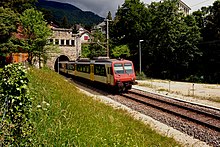Grenchenberg tunnel
The Grenchenberg tunnel ( French Moutier – Granges tunnel ) is a 8,578 meter long single-lane Swiss railway tunnel operated by BLS on the Jura railway line from Delémont to Biel . It crosses under Graitery and Grenchenberg in the southern Jura ridge and creates a connection between the Grand Val near Moutier and the Mittelland near Grenchen .
The northern tunnel portal at Moutier is 535 m above sea level. M. and the south portal at Grenchen at 484 m above sea level. M. The tunnel axis is apart from 55 meters at the northern entrance where the axis makes a bow, straight, rising from Moutier for almost 4 km of easy 2.5 ‰ and then leans in a gradient of 13 ‰. Due to the relatively narrow clearance profile , the tunnel noises are extremely loud while driving through the Grenchenberg tunnel.
prehistory
In 1877 the Jura railway from Basel / Delle – Delémont – Moutier – Tavannes –Biel was completed and connected the French Eastern Railway (EST) from Paris to Bern . Until before the First World War , the difficult and long line was very unattractive for direct connections, and traffic from Paris wound mainly on the lines of the Compagnie Paris-Lyon-Méditerranée (PLM) via Pontarlier - Vallorbe - Lausanne and Ambérieu - Geneva to the Simplon tunnel and continue towards Italy . When the construction of the Lötschbergbahn was certain at the turn of the century , the solution to the long journey from Delle and Basel to Bern was found in the construction of a shortened tunnel connection from Moutier to Biel. To the displeasure of the federal railways, the Berner Alpenbahn-Gesellschaft Bern-Lötschberg-Simplon (BLS) received the concession for the construction and operation of the Münster-Lengnau-Bahn (MLB) in 1909 , and a state treaty between France and Switzerland secured the participation of EST 10 million Swiss francs on the construction of the 13-kilometer shortcut railway.
construction
On October 26, 1911, the building contract with the building company Société franco-suisse de construction du chemin de fer Moutier-Longeau, F. Allard, L. Chagnaud, A. Couvreux, J. Dollfuss, V. Prudhomme, L. Wiriot et F Rothpletz completed.
Construction work began on November 6th (south side) and November 7th (north side).
Initially, the tunnel was driven with hand drilling and later with machine drilling. In 1913, geology made further eruption difficult . In February groundwater was found , of which 250 l / s water poured into the tunnel. It was even worse in March 1913 with 370 l / s of water, so that the advance had to be stopped completely. As a result, drinking and service water was withdrawn from the entire village of Grenchen.
The outbreak of World War I on August 1, 1914 also impaired construction work. On October 27, 1914 was carried breakdown of the tunnel, on October 1, 1915 could he and the whole range of MLB traffic passed.
Data
Construction process
- Start of construction in Moutier: Monday 6 November 1911
- Start of construction in Grenchen: Tuesday, November 7th, 1911
- Penetration of the bottom tunnel on October 24, 1914, 4.30 p.m.
- The keystone was laid on July 24, 1915
- Acceptance of the construction and first train through the tunnel on September 16, 1915
- The company opened on October 1, 1915
building-costs
- Estimate 1912: Fr. 26,022,000.-
- Expenditures up to 1916: CHF 25,718,735.19
construction
- An average of 1,057 workers were employed and performed 531,671 working day shifts
- The total excavation was around 350,000 m³
- Around 359,000 kg of explosives were used
Accidents
- Total 1,108 accidents with incapacity for work of six or more days
- Total of 12 fatal accidents
business
The Münster-Lengnau-Bahn belonged to the Bern-Lötschberg-Simplon-Bahn (BLS) from the start. She operated and maintained both the facilities and the tunnel. The train operation, however, was always carried out by the SBB .
A special feature was the tunnel ventilation , which was used until electrification in 1928. Because of the poisonous gases that got stuck due to the steam operation , solutions were required when the tube was opened. In order to have a system that is completely independent of the weather , a special ventilation building was built at the south portal. There were two impressive fans with a diameter of 3.5 meters, which, driven by a 200 HP electric motor, sucked in fresh air and blew it into the inside of the tunnel. This created an air flow of 3 m / s and the tunnel was fully ventilated every 50 minutes. In order for this system to work properly even in the most adverse air conditions, the south portal had to be closed with a canvas curtain. This system required constant maintenance, as the curtain had to be raised and lowered again in good time when a train approached. Later a signal system, which was coupled with the curtain mechanism, took over the protection. In 1940 the curtain and the signal protection were removed and the ventilation shut down. The former ventilation building in Grenchen is still standing at the tunnel entrance on the left in front of the south portal.
numbers and facts
| Construction time: | 1911-1915 |
| Design type: | Single track tunnel |
| Length: | 8578 meters |
| Tilt: | 2.5 ‰ and 13 ‰ |
| Electrification: | May 15, 1928 |
Redevelopment
Between 2005 and 2007 the tunnel and its infrastructure were extensively renovated. In addition to the renewal of the railway systems, the tunnel vaults, the tunnel floor and the drainage system were renovated and facilities for emergencies were installed.
swell
- Encyclopedia of Railways (1914), Volume 5, p. 370
- 3x50 years - Swiss railways in the past, present and future (1997)
- 40 Switzerland's transport attractions, Werdverlag, 1991

